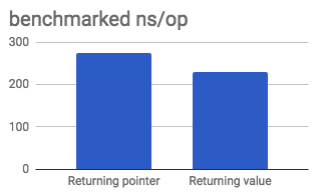TL;DR
Despite copying a struct with several fields is slower than copying a pointer to the same struct, returning a struct value may be faster than returning a pointer if we consider escape analysis particularities.
Returning structs allows the compiler to detect that the created data does not escape the function scope and decides to allocate the memory in the stack, where the allocation and deallocation is very cheap if compared to managing memory in the heap.
Toy Scenario
Let's consider a machine to create Donuts with diversity of sizes, shapes and ingredients:
type Donut struct {
Radius float32
Thick float32
Toppings []string
GlutenFree bool
Hole bool
Filling string
}
In a 64-bit machine, the above struct would have a minimum size of
4+4+16+1+1+12 = 38 bytes, and I emphasize minimum because some implementations
of Go could decide to, e.g. use bigger data structures for booleans or slice/string
metadata.
Considering that a 64-bit pointer (8 bytes) is several times smaller than 38 bytes, one may think that the following factory function:
func RandomDonut() *Donut
Should be faster than an analogue function that returns a copy of the Donut:
func RandomDonut() Donut
Experiment 1: benchmarking
Given the following function:
const maxToppings = 3
var radiuses = []float32{5, 10, 15}
var thicks = []float32{2, 3, 4}
var toppings = []string{"Chocolate", "Nuts", "Sugar", "Caramel"}
var fillings = []string{"", "Mermelade", "Chocolate", "Cream"}
var rnd = rand.New(rand.NewSource(321))
func RandomDonut() *Donut {
d := Donut{
Radius: radiuses[rnd.Intn(len(radiuses))],
Thick: thicks[rnd.Intn(len(radiuses))],
}
if rnd.Int()%2 == 0 {
d.GlutenFree = true
} else {
d.GlutenFree = false
}
if rnd.Int()%2 == 0 {
d.Hole = true
} else {
d.Hole = false
d.Filling = fillings[rnd.Intn(len(fillings))]
}
numToppints := rnd.Intn(maxToppings)
d.Toppings = make([]string, 0, maxToppings)
for i := 0; i < numToppints; i++ {
d.Toppings = append(d.Toppings,
toppings[rnd.Intn(len(toppings))])
}
return &d
}
, and an analogue func RandomDonut() Donut function that is exactly equal to the
above function, but returning the Donut by value; we have benchmarked and traced
both versions:
func BenchmarkSweets(b *testing.B) {
for n := 0; n < b.N; n++ {
RandomDonut()
}
}
For this particular function, returning a value instead to a pointer makes the operation time decrease by 16%, as the following graph shows (lower is better):

Of course the difference may be different depending on the size of the struct or the total execution time of the function.
Experiment 2: tracing
The above benchmarks have been repeated and executed during 5 seconds with the
-trace option enabled. To allow us inspect the trace with go tool trace tool
(see above screenshot).

The inspection of the go trace tool shown that the number of invocations to the
Garbage Collector is cut down by 50%, and the time during which the Garbage Collector
is running is cut in a similar proportion.

These results also would vary on other functions. The example function generates a small amount of heap memory to store the Donut toppings.
Conclusions
(Please refer to the TL;DR in the beginning of this entry 😇)
Next steps
- Evaluate whether arguments by reference make the compiler consider that the generated structs escaped the scope of the function that generated it.
- Evaluate from which struct size is faster to return pointers.
- Evaluate how the performance is penalised when structs are returned through a larger stack trace.